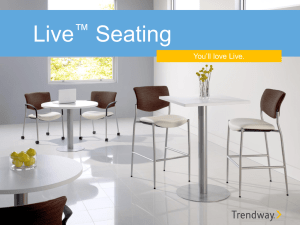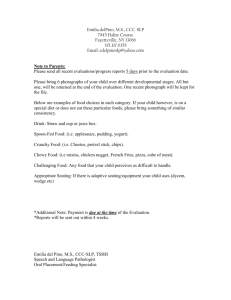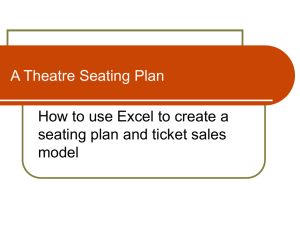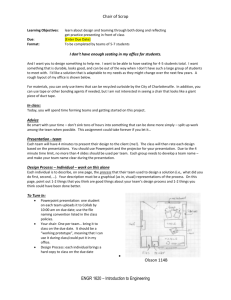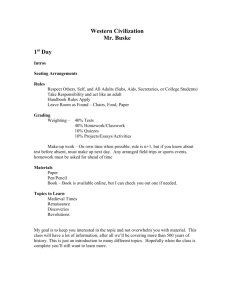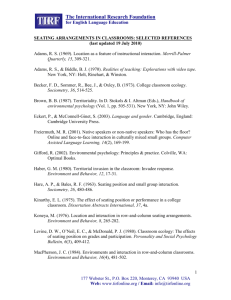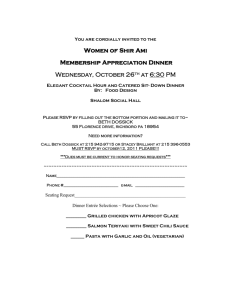FOLDING BLEACHER COMPANY - Forum Athletic Products Inc.
advertisement
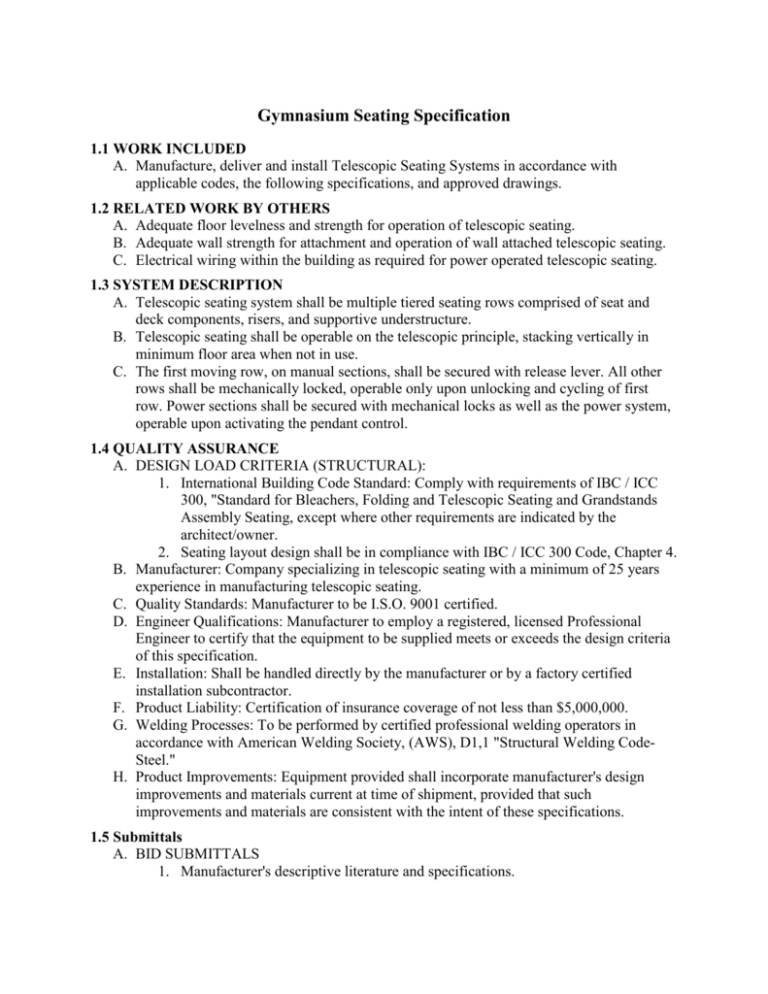
Gymnasium Seating Specification 1.1 WORK INCLUDED A. Manufacture, deliver and install Telescopic Seating Systems in accordance with applicable codes, the following specifications, and approved drawings. 1.2 RELATED WORK BY OTHERS A. Adequate floor levelness and strength for operation of telescopic seating. B. Adequate wall strength for attachment and operation of wall attached telescopic seating. C. Electrical wiring within the building as required for power operated telescopic seating. 1.3 SYSTEM DESCRIPTION A. Telescopic seating system shall be multiple tiered seating rows comprised of seat and deck components, risers, and supportive understructure. B. Telescopic seating shall be operable on the telescopic principle, stacking vertically in minimum floor area when not in use. C. The first moving row, on manual sections, shall be secured with release lever. All other rows shall be mechanically locked, operable only upon unlocking and cycling of first row. Power sections shall be secured with mechanical locks as well as the power system, operable upon activating the pendant control. 1.4 QUALITY ASSURANCE A. DESIGN LOAD CRITERIA (STRUCTURAL): 1. International Building Code Standard: Comply with requirements of IBC / ICC 300, "Standard for Bleachers, Folding and Telescopic Seating and Grandstands Assembly Seating, except where other requirements are indicated by the architect/owner. 2. Seating layout design shall be in compliance with IBC / ICC 300 Code, Chapter 4. B. Manufacturer: Company specializing in telescopic seating with a minimum of 25 years experience in manufacturing telescopic seating. C. Quality Standards: Manufacturer to be I.S.O. 9001 certified. D. Engineer Qualifications: Manufacturer to employ a registered, licensed Professional Engineer to certify that the equipment to be supplied meets or exceeds the design criteria of this specification. E. Installation: Shall be handled directly by the manufacturer or by a factory certified installation subcontractor. F. Product Liability: Certification of insurance coverage of not less than $5,000,000. G. Welding Processes: To be performed by certified professional welding operators in accordance with American Welding Society, (AWS), D1,1 "Structural Welding CodeSteel." H. Product Improvements: Equipment provided shall incorporate manufacturer's design improvements and materials current at time of shipment, provided that such improvements and materials are consistent with the intent of these specifications. 1.5 Submittals A. BID SUBMITTALS 1. Manufacturer's descriptive literature and specifications. 2. List of deviations from these specifications, if any. 3. Certification of Insurance. 4. I.S.O. 9000 Certification. B. JOB SUBMITTALS 1. Shop Drawings showing all equipment to be furnished with details of accessories to be supplied including necessary electrical service to be provided by others. All electrical submittals must include U.L. listing number. 2. Samples of material and color finish as requested by Architect. 3. Warranty, operation and maintenance instructions to the owner upon completion. 1.6 Design Criteria A. Telescopic seating shall be designed to support, in addition to its own weight, and the weight of added accessories, a uniformly distributed live load of not less than 100 lbs. per sq. ft. (4.8 kN per sq. m.) of gross horizontal projection. 1. Seat boards and footrest shall be designed for a live load of not less than 120 lbs. per linear foot (1.751 kN per linear m). 2. A sway force applied to seats shall be 24 lbs. per linear ft. (350 N per linear m.) parallel to the seats and 10 lbs. per linear ft. (146 N per linear m.) perpendicular to the seats. Sway forces shall not be considered simultaneously applied. B. Railings, posts and sockets designed to withstand the following forces applied separately: 1. Handrails shall be designed and constructed for: a. A concentrated load of 200 lbs. (890 N) applied at any point and in any direction. b. A uniform load of 50 lbs. per ft. (730 N/m) applied in any direction. The concentrated and uniform loading conditions shall not be required to be applied simultaneously. 2. Guards shall be designed and constructed for: a. A concentrated load of 200 lbs. (890 N/m) applied at any point and in any direction along the top railing member and; a uniform load of 50 lbs. per ft. (730 N/m) applied horizontally at the required guardrail height and simultaneous uniform load of 100 lbs. per ft. (1460 N/m) applied vertically downward at the top of the guardrail. The concentrated and uniform loading conditions shall not be required to be applied simultaneously. b. American Institute of Steel Construction (AISC), American Iron and Steel Institute (AISI) and Aluminum Association (AA) design criteria shall be the basis for calculation of member sizes and connections. c. Wood members shall be designed in accordance with National Forest Products Association, (NFOPA), and National Design Specification for Wood Construction. 1.7 WARRANTY A. The manufacturer shall warrant all work performed under these specifications to be free of defects for a period of one year. B. Any materials found to be defective within this period will be replaced at no cost to the owner. This warranty shall not include replacements required by Acts of God, war, vandalism, flood, fire, calamity or deliberate abuse or misuse of the equipment. 2.1 ACCEPTABLE MANUFACTURERS A. All seating shall be the Irwin Model 4500 as manufactured by Irwin Telescopic Seating Company, Altamont, IL 62411 or equal, subject to prior approval and strict compliance with these specifications. 2.2 MATERIALS A. Seating Area: Groups Feet Inches Long, Rows High (Wall and Floor Attached), (Recessed), (Movable), (Forward Fold), (Manually or Electrically Operated). B. Dimensions: 1. Overall height: Feet Inches 2. Open depth: Feet Inches 3. Closed depth: Feet Inches 4. Row Spacing: (22, 24, 26 or 31, 32, 33) Inches 5. Rise per row: (10, 12, 14, 16) Inches C. Accessories: (Select) 1. Aisles shall be footrest level inches wide to provide aisles. Aisles at the footrest level shall have non-slip treads on the top front edge. 2. Intermediate aisle steps shall be provided. Steps are permanently attached closed design. Steps shall be designed to eliminate any possible toe catch between the top of the intermediate step and the bottom of the nose beam per ADA or other applicable codes. Front step shall be hinged for storage on first row deck without the need for removal. 3. Aisle handrails. (Select a, b or c) a. Smart Rail aisle handrails shall be provided for row spacing between 22” and 26”. Aisle railings shall quickly and easily rotate 90 degrees to the locked position and store parallel to the front of the aisle. Railings that require removal from the pocket or the use of tools for storage will not be acceptable. Aisle railings shall also be capable of remaining in the use position during operation, eliminating any rail setup or takedown time. Aisle railings shall be an individual rail design, located on every other row starting at row two (2). Railing to be constructed of 1 1/2” 11 ga. round steel tubing, finished in a textured powder coated epoxy. For safety, railings designed without a full return of the handrail will not be acceptable. b. Smart Rail EX aisle handrails shall be provided for row spacing between 31” and 33”. Aisle railings shall quickly and easily rotate 90 degrees to the locked position and store parallel to the front of the aisle. Railings that require removal from the pocket or the use of tools for storage will not be acceptable. Aisle railings shall be an individual rail design, located on every other row starting at row two (2). Railing to be constructed of 1 1/2” 11 ga. round steel tubing, finished in a textured powder coated epoxy. For safety, railings designed without a full return of the handrail will not be acceptable. c. Removable aisle handrails shall be provided. Aisle railings shall be an individual rail design, located on every other row starting at row two (2). Railing to be constructed of 1 1/2” 11 ga. round steel tubing, finished in a textured powder coated epoxy. Aisle rails spanning several rows, or rails made from square tubing will not be acceptable. For safety, rail pockets that protrude beyond the face of the bleacher while in the closed position or railings with blunt, non-turned ends will not be allowed. 4. Wheel Chair Seating Areas. (Select a, b or c) a. Permanent wheel chair spaces shall be provided at the section joint location or section length as shown on plans. Permanent notches to have a Panelam closure panel to eliminate any open areas under the system. Closure panels to support row two eliminating damage to the understructure or the need for front railings. b. Recoverable wheel chair spaces shall be provided at the section joint location or section length as shown on plans. An integral support on row two shall be provided to eliminate structural damage to the understructure during the operation and use of the system. Recoverable seating areas do not require front railings for support. c. Modular Deck Units (MDU’s) shall be provided throughout the first seating row. Each MDU will vary in size depending on overall group length and aisle location. MDU’s can be arranged in multiple configurations as required. Each MDU shall be manually opened and closed with the power system starting at row two. An integral support on row two shall be provided on any rise above 10” to eliminate structural damage to the understructure during the operation and use of the system. MDU’s do not require front railings. 5. End rails. (Select a or b) a. End rails of the self-storing type, finished with textured epoxy powdercoated black enamel, shall be provided at the open ends of the group. End rails shall start at row three and meet all national building codes. Railings with flexible uprights that can be expanded beyond the 4” sphere are not acceptable. b. End rails of the vertical, removable type, finished with textured epoxy powder-coated black enamel, shall be provided at the open ends of the seating areas. Each area the rails are intended to be used shall be equipped with permanent slide-out pockets allowing the rails to be securely attached. End rails shall start at row three and meet all national building codes. Railings with flexible uprights that can be expanded beyond the 4” sphere are not acceptable. 6. End panels of plywood and supports shall be provided to enclose the open ends of the group in the closed position. End panels shall enclose the space between the wall and the back of the self-storing end rails. Finish to match deck panels. 7. Vinyl end curtain closures. (Select a, b or c) a. Vinyl end curtains shall be provided to limit unauthorized access to the underside of the telescopic system. Curtain to be one piece design shaped to follow the angle of the telescopic unit in the open position, and constructed of a sturdy vinyl material with sewn-in grommets for attachment. Color to be selected from manufacturer’s standard selection. b. Vinyl end curtains with printed school logo shall be provided to limit unauthorized access to the underside of the telescopic system. Curtain to be one piece design shaped to follow the angle of the telescopic unit in the open position, and constructed of a sturdy vinyl material with sewn-in grommets for attachment. Each curtain shall include a school logo up to 40” in size. Color to be selected from manufacturer’s standard selection. c. Vinyl end curtains with custom graphics shall be provided to limit unauthorized access to the underside of the telescopic system. Curtain to be one piece design shaped to follow the angle of the telescopic unit in the open position, and constructed of a sturdy vinyl material with sewn-in grommets for attachment. Each curtain shall include full custom graphics as selected by the architect/owner. 8. Scorer’s table shall be 8’ x 15” wide of wood grain high pressure laminate. Scorer’s table shall be relocatable to any row of any section without the use of mounting sockets. 9. Seat numbers and row letters shall be supplied in a silver matte finish with black identification. Layout of numbering to be coordinated with the architect/owner. 10. Supply custom seat end graphics of school logo or mascot at each aisle seat location. Each graphic shall include full digital printing using a 4 color process, and be sized to follow the entire seat profile. Seat graphic available only with the Infinity seat module. 11. Seat level rear filler panels used to close openings between top row seat and wall. Closure panel to match panelam deck surface. 12. Folding Back Supports (U.S. Patent #7,267,403) shall be permanently attached to each seating position and shall fold forward and store on the seat. Each individual back support is easily raised into the use position by the patron, and will close automatically with the operation of the bleacher system. Each back support shall be blow-molded, double walled, impact resistant polyethylene plastic in a textured finish. Colors to be coordinated with the plastic seat module or as selected by architect/owner. Each back support shall have one location on the front side for a seat donor tag, and one location on the back for a seat number tag. The folding back support requires a minimum of 26” row spacing and 12” rise. Folding back support available only with the BlowMold seat module. 13. Fold-Down Backrests shall be permanently attached behind each seating row (except the last row) and shall fold and store on the deck without the need for removal. All backrest support brackets shall be finished in a texture powder coated epoxy. Backrest boards shall be 3/4” thick x 5” high clear yellow pine graded “B & better” and finished with clear polyurethane on all sides. Fold-down backrest requires a minimum of 31” row spacing. 14. Portable operator handle with tug frames for use in assisting manually operated bleachers shall be supplied. “T” frame handle to allow two operators to open and close bleacher sections from a standing position. 15. Full width back panels for portable, forward fold or freestanding units shall be provided. Panels shall extend to 8’ above the floor with a sturdy vinyl curtain material extending to the underneath side of the last row seat. Finish to match deck panels. Aluminum trip to be supplied for finishing all exposed ends. Curtains to be selected from manufacturer’s standard colors. Plywood shall be supported along the front and back edge for maximum rigidity. Plywood with clear or painted finish is unacceptable. 16. Rear rails, 42” high for portable and forward fold units with tubular supports to fill design criteria, shall be provided. Rails to be mounted behind the rear seat and extend the full length of the seating section. Railings to be finished in textured powder coated epoxy. 17. Transport systems for portable units. (Select a or b) a. Integral Airlift System: Provide each portable seating section with a minimum of 2 self-contained integral airlift units. Each lift unit to be constructed from heavy gauge steel designed to support the overall weight, as well as the forces applied in relocating the seating unit. Each seating section shall be equipped with a minimum of 4 swiveling Tri-Caster assemblies (12 individual caster wheels). The total number and type of caster to be determined by the manufacturer based on the overall weight and flooring surface. To reduce the effort needed to relocate the seating unit and allow greater mobility, each caster assemble shall be attached to a caster plate that swivels independently of the tri-casters by means of high quality ball bearings. Each seating section shall be equipped with quick disconnect air valves at both ends of section for ease of operation. Supply one 1-1/2 HP 125 PSI portable air compressor with tank. Architect/owner to coordinate the compatibility of the portable seating and floor surface with the flooring manufacturer. b. Portable Dollies: Provide a pair of mobile hydraulic lift dollies suitable for the transport of portable seating. Each lift dolly to be constructed from heavy gauge steel designed to support the overall weight, as well as the forces applied in relocating the seating unit. Each seating section shall be equipped with a minimum of 4 swiveling Tri-Caster assemblies (12 individual caster wheels). The total number and type of caster to be determined by the manufacturer based on the overall weight and flooring surface. To reduce the effort needed to relocate the seating unit and allow greater mobility, each caster assemble shall be attached to a caster plate that swivels independently of the tri-casters by means of high quality ball bearings. Architect/owner to coordinate the compatibility of the portable seating and flooring surface. Architect/Owner to coordinate the compatibility between seating unit and floor surface with the flooring manufacturer. 2.3 FABRICATION A. Understructure System: 1. Steel supports and rolling frames shall be constructed of formed steel shapes of the size and shape necessary to support the design loads. All support bracing shall begin at Row 2 and be of diagonal or "knee" type for rigidity. Diagonal bracing to be a "U" shaped formed steel channel. Angle iron or "X" type bracing is unacceptable. 2. Wheels shall not be less than 4" diameter x 1" non-marring soft rubber face to protect wood or synthetic floor surfaces. Each operating row shall have a minimum of 8 wheels. 3. Each fully skirted wheel channel shall be continuously in contact with adjacent channels by nylon guides, to eliminate metal-to-metal contact, and non-binding Quadra-Link guide rods to provide alignment when opening and closing. Wheel channels do not required either at time of installation or periodically. 4. Each cantilever arm shall be triple-formed 10-gauge steel, securely welded to the post assembly and contain non-binding Quadra-Link interlocks with each row post assembly. Each post assembly shall include a 1 3/16” wide x 3/4" nylon roller to enhance the overall operation and provide proper load support. Roller to be connected using a 3/8” diameter pin. Cantilevers not properly supported with a roller design will not be acceptable. Cantilevers do not require lubrication at time of installation or periodically. 5. Vertical columns shall be high tensile steel structural tube to meet design criteria. Minimum column size to be 1 1/2” by 3” 11-gauge structural tube. 6. Deck supports shall be bolted to the rear beam, nose and decking with locking hardware. B. Seat Systems: (Select 1, 2, 3, 4 or 5) 1. BlowMold Seat: Supply plastic modular 18” individual seats in either 10” or 12” deep models. Seating to be scuff resistant blow molded high density polyethylene plastic. Select: 10” BlowMold Seat to be supplied Select: 12” BlowMold Seat to be supplied a. Seats shall be blow-molded, double-walled, high density, impact resistant, UV stabilized, linear polyethylene available in 15 bright standard colors. Custom colors available as an option. b. Each module to be bracket supported with concealed mounting hardware attachment for rigidity. c. Modules shall allow a full 26 1/4" unobstructed area for foot room comfort and cleaning. Modules with external ribs or multiple piece modules are not acceptable. d. Each module has two recessed areas for seat number locations. Number plates are optional. 2. 4/4” Nominal Lumber: Seats shall be 3/4” thick, 10” nominal depth, kiln dried, finger jointed, solid or edge glued Southern Pine Grade “C and better” upgraded to “B and better” to conform with Southern Pine Inspection Bureau, (SPIB), Grading Rules. Seat boards shall be continuously supported along the front edge. Riser boards shall be an actual dimension of 8” wide by 3/4” thick, finger jointed, solid or edge glued Southern Pine Grade “C and better” upgraded to “B and better” in conformity with SPIB Grading Rules. Wood seats and riser boards to be machine and hand sanded and finished with a moisture repellent sealer coat on all surfaces. Finish to be UV cured, water based polyurethane with a high gloss clear coat. 3. 5/4” Nominal Lumber: Seats shall be 1” thick, 11” actual depth (10” depth on 22” spacing) finger jointed, solid or edge glued Southern Pine Grade “C and better” upgraded to “B and better”. Riser boards shall be an actual dimension of 8” wide by 3/4” thick, finger jointed, or edge glued solid Southern Pine Grade “C and better” upgraded to “B and better” in conformity with SPIB Grading Rules. Wood seats and riser boards to be machine and hand sanded and finished with a moisture repellent sealer coat on all surfaces. Finish to be UV cured, water based polyurethane with a high gloss clear coat. 4. Integra Chair: Supply fold-down chairs on telescoping platforms with seats, backs, and a full complement of standards, fold-down mechanism and all support structure required for a fully functional seating system. a. Platform chairs shall have a modern look with complimentary style lines, comfortable contours and subtle texture to achieve maximum spectator comfort. b. Each chair to be constructed from durable, scuff resistant injection molded high density polypropylene plastic, designed to support over 700 pounds per chair. c. Seat heights shall be maintained at a minimum of 17 ½”. Lower seat heights which detour from spectator comfort will not be accepted. d. Actual seat width shall not be less that 17 ¼” e. Back heights to be a minimum of 31 ½” and designed to fold within the depth of the deck when in the stored position. Chairs extending beyond the face of the unit when closed will not be acceptable. f. Chairs shall be rail mounted and allow for complete flexibility in chair layout. Seat spacing to be available from 18” to 24”, and field adjustable. g. Each chair shall have the capability of using seat numbers and row letters at the aisle locations. Seat numbers and row letters to have a stylish round design to enhance the aesthetic value of the seat, and be recessed to protect against vandalism. h. Select seating colors from manufacturer’s 15 standard colors. Custom colors available as an option. i. Securely fasten each chair and arm assembly to a heavy duty, clear anodized aluminum rail using locking hardware. Fold-Down System: (Select 1 or 2) 1. MANUAL OPERATION: The fold-down system shall be manually operated permitting up to four chairs to be raised / lowered at one time, with minimal effort. Chairs shall readily lock in the upright position when raised without initiating a specific locking operation. Manual lowering of chair shall be done by simply depressing a foot release lever allowing the chairs to fold flat on the deck surface. Any folding system requiring the weight of the chairs to be lifted in order to fold will not be acceptable. 2. SEMI-AUTOMATIC OPERATION: The fold-down system shall be full semi-automatic operation. The raising and lowering of the chairs shall be accomplished with ease by a single operator. Locking of chairs in the use position shall be totally independent of platform operation. Locking system and hinge system shall be shrouded over their total length to prevent debris from interfering with the latching mechanism. Lowering of the chairs shall be strictly done by the closing of the platform system, with the exception of the first row and any programmable rows, which shall be released manually. Telescopic systems requiring chairs to be release and folded row by row will not be acceptable. Chair Type: (Select 1, or 2) 1. PLASTIC SEATS AND BACKS: Seats and backs shall be of high impact resistant injection molded polypropylene plastic, with a textured surface. The face of the seat and back shall be compoundcontour molded to promote comfort, uninterrupted by surface grooves with no exposed hardware. Seats and backs shall be provided with the ability to add upholstered pads at a later date. 2. UPHOLSTERED SEATS AND BACKS: Seat and back shall include upholstered padding that maximized overall chair comfort and aesthetics. Upholstery culls shall be foam wrapped with the seat to receive 1” of foam and 5/8” in the back. Foam material shall be of new (prime manufacture) polyurethane foam, and comply with the flammability requirements outlined in California Technical Information Bulletin #117, Resilient Cellular materials, Section A & D, dated February 1975, when tested in accordance with Federal Test Method Standard 191, Method 5903.2. Fabric shall be supplied as specified by Architect / Owner, or selected from manufacturer’s standard. Armrest Type: (SELECT 1 or 2) 1. ARMRESTS: Armrests shall be injection molded plastic, and shall be securely attached to the support structure by concealed fastener, capable of rotating to a vertical position for storage. Armrest rotation mechanism shall be completely shrouded to prevent any pinching or snagging hazard. Armrest support shall be designed to allow for adjustments in chair width to facilitate row alignment. Armrests to be supplied in a satin black finish. 2. CUPHOLDER ARMREST: Cupholder armrests shall be injection molded plastic, and shall be securely attached to the support structure by concealed fastener, capable of rotating to a vertical position for storage. Armrest rotation mechanism shall be C. completely shrouded to prevent any pinching or snagging hazard. Armrest support shall be designed to allow for adjustments in chair width to facilitate row alignment. Cupholder armrests to be supplied in a satin black finish. Select: 1. NUMBER AND LETTER PLATES: Chairs shall be provided with a number identification system, featuring a 1” round design number plate, attached to the bottom of the seat. Aisle letters shall be located on the side of the armrest and be a minimum 2 ¼” for easy identification. Deck System: (Select 1 or 2) 1. Decking: Panelam decking shall have a 0.030 (30 thousandths) high density polyethylene overlay, permanently bonded over 5-ply structural western fir plywood in strict compliance with U.S. Product Standard PS 195. Finish thickness to be 5/8”. Polyethylene finish to be textured grey or beige. Plywood shall be supported along the front and back edge for maximum rigidity and designed in a manner that allows 3 plies to run front to back for increased deck strength. Each plywood panel shall be connected using a tongue and groove splice leaving the deck clean and free of any tipping or cleaning obstructions. Plywood with clear or painted finish is unacceptable. Decking shall be throughbolted to steel supports with locking hardware. Decking attached by the use of self-tapping fasteners or retained by friction only is unacceptable. 2. Decking: AlumaClad decking shall have a 0.013 (13 thousandths) aluminum overlay, permanently bonded to 5-ply structural western fir plywood in strict compliance with U.S. Product Standard PS 195. AlumaClad to have Stucco textured anodized aluminum finish. Decking shall be supported along the front and back edge for maximum rigidity and designed in a manner that allows 3 plies to run front to back for increased deck strength. Each deck panel shall be connected using a tongue and groove splice leaving the deck clean and free of any tipping or cleaning obstructions. Decking shall be through-bolted to steel supports with locking hardware. Decking attached by the use of self-tapping fasteners or retained by friction only is unacceptable. 3. Nosing: Nosing with panelam decks shall be one piece, formed, 14-gauge steel with a minimum G-60 pre-galvanized finish. 4. Rear Risers: Rear riser shall be a minimum 14-gauge formed steel with a minimum G-60 pre-galvanized finish. 5. Formed Steel Deck Support Members: Support members shall be double formed 10-gauge steel and connect the front nosing and rear riser members. Each deck support shall include a 1 1/2” wide x 3/4" nylon roller to enhance the overall operation and provide proper load support. Roller to be connected using a 3/8” diameter pin. Cantilevered rollers supported on 1 side only which can bend under occupant load will not be acceptable. Deck supports shall provide support for the decking, throughout its length, and at intermediate locations to limit deflection. Deck supports to have a maximum spacing of 60” up to 26” row spacing, and 40” up to 33” row spacing. D. Finish 1. For rust resistance in standard or high humidity conditions all painted surfaces shall be finished in textured Epoxy Powder Coated Semi-Gloss Black. 2.4 PROPULSION SYSTEM (Select A or B) A. MANUAL: For manually operated bleachers, individual sections containing a series of tiered rows shall be manually opened and closed. Each tiered row shall have mechanical locks to keep rows fully extended when in the open position. Row locks shall automatically release upon operation of release lever in the front skirt panel. Hinging of the lower skirt board is not acceptable. B. FRICTION POWER: Furnish each seating group with an integral friction drive system to open and close the telescopic units. Each individual section shall include 2 friction drive systems integrated into the first moving row of understructure to achieve smooth and efficient operation. Operation of the seating shall be accomplished with the use of a walk along pendant control. 1. Each power system shall include two large 6 1/2" diameter by 4" long friction rollers, for a total of 4 rollers per section. Each roller to include non-marring 1/2" thick rubber covering. 2. Electrical motors for each section shall be heavy duty and high efficiency gear reduction motors. The shaft diameter for the gear motor and rollers shall be a minimum of 1” and be connected by a 1” schedule 40 drive shaft. 3. All roller chain and sprockets used throughout the drive system shall be a minimum of #50 in size. Each drive unit shall be designed to include a safety shroud around the chain and sprocket for overall safety, and to protect the floor surface should a chain failure occur. 4. The power units shall develop tractive forces adequate to operate the seating units under normal conditions but inadequate to operate should significant obstacles be encountered. C. Manufacturer shall provide all wiring from power source within bleacher seating including pendant control. Removable pendant control shall be hand held with forward and reverse button, plugging into a single receptacle. Electrical contractor shall provide a 60 HZ power source (as specified below) behind each group of seating. Amperage to be as specified by seating manufacturer depending on the number of power units required. For wall-attached installations, power source to terminate in a surface mounted junction box above floor. For reverse units; power source to terminate in a junction box, flush mounted under first seating row in center of group. Electrical contractor shall perform the connections to the seating equipment at the junction box. All electrical parts and wiring shall be installed in complete accord with the National Electric Code. All systems shall be designed to comply with U.L. (U.L. Listing #E168517). Select: Supply power system with 208/230V, 5 wire 3-phase system. Select: Supply power system with 120V single phase system. 3.1 REVIEWS AND APPROVALS A. Shop drawings shall be approved and job site field measurements taken prior to installation and telescopic gym seating shall be installed in conformance therewith. 3.2 INSTALLATION A. The installation of the telescopic gym seating will be handled directly by the manufacturer or by a factory authorized installation subcontractor qualified to perform the installation function. 3.3 PROTECTION A. The manufacturer’s representative shall transmit instructions in both operation and maintenance to the owner. B. Maintenance and operation of the telescopic gym seating shall be the responsibility of the owner or his duly authorized representative, and shall include the following: 1. During operation of the telescopic gym seating, the opening and closing shall be supervised by responsible personnel who will assure that the operation is in accordance with the manufacturer's instructions. 2. Only attachments specifically approved by the manufacturer for the specific installation shall be attached to the telescopic gym seating. 3. An annual inspection and required maintenance of all telescopic gym seating shall be performed to assure safe conditions. At least bi-annually, the inspection shall be performed by a Professional Engineer or factory service personnel. C. Irwin Telescopic Seating Company constantly strives to improve its product and manufacturing methods; therefore, it reserves the right to make changes without notice which, in the opinion of Irwin Telescopic Seating Company, shall improve the product.
